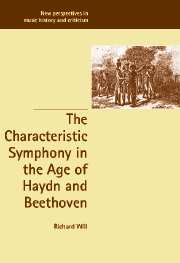Book contents
- Frontmatter
- Contents
- Acknowledgments
- Note to the reader
- Introduction
- 1 Paradise lost: Dittersdorf's Four Ages of the World and the crisis of Austrian enlightened despotism
- 2 Preaching without words: Reform Catholicism versus divine mystery in Haydn's Seven Last Words
- 3 The boundaries of the art: characteristic music in contemporary criticism and aesthetics
- 4 Paradise regained: time, morality, and humanity in Beethoven's Pastoral Symphony
- 5 Making memories: symphonies of war, death, and celebration
- Appendixes
- Bibliography
- Index
4 - Paradise regained: time, morality, and humanity in Beethoven's Pastoral Symphony
Published online by Cambridge University Press: 11 January 2010
- Frontmatter
- Contents
- Acknowledgments
- Note to the reader
- Introduction
- 1 Paradise lost: Dittersdorf's Four Ages of the World and the crisis of Austrian enlightened despotism
- 2 Preaching without words: Reform Catholicism versus divine mystery in Haydn's Seven Last Words
- 3 The boundaries of the art: characteristic music in contemporary criticism and aesthetics
- 4 Paradise regained: time, morality, and humanity in Beethoven's Pastoral Symphony
- 5 Making memories: symphonies of war, death, and celebration
- Appendixes
- Bibliography
- Index
Summary
Three decades after the premiere of Dittersdorf's Metamorphoses, another audience gathered in Vienna to hear Beethoven's now-legendary academy of 22 December 1808. As in 1786, the program began with an orchestral representation of paradise, the first movement of the Pastoral Symphony. The setting was contemporary, a place that real people might visit rather than a distant Golden Age: this, in any event, is the implication of the movement title, “Erwachen heiterer Empfindungen bei der Ankunft auf dem Lande” (Awakening of happy feelings on the arrival in the countryside), which echoes references in Beethoven's letters to escaping the city for rural retreats. Yet there is no mistaking the effort to conjure a world protected from violence, degradation, human foible – a desire to transport listeners into a haven of calm, in the tradition not only of Les Quatre Ages du monde but also of other works both pastoral and, as we shall see in Chapter 5, military. In retrospect, after the second half of the concert had opened with Beethoven's Fifth Symphony, the initial repose in the countryside must have seemed all the more idyllic.
The Pastoral goes on to follow an equally familiar trajectory among characteristic symphonies, a passage from calm to turmoil and back, or from calm to turmoil to celebration.
- Type
- Chapter
- Information
- The Characteristic Symphony in the Age of Haydn and Beethoven , pp. 156 - 187Publisher: Cambridge University PressPrint publication year: 2002

